| redirections
I've spent the last year acquiring my photography kit, which I've chronicled here. Now life is letting me start to shoot with it. As I use the gear and get the photographs back some of the directions I've gone in have worked fine while others need new directions. This is about a photograph that didn't do what I wanted and a thread in Rangefinder Forum that helped answer the problem and provided some new directions.
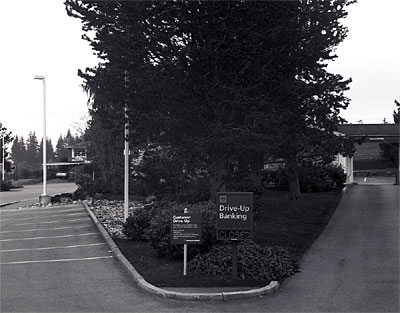
bigger
This is my first exposure with the Burke & James. Some things worked great. There was an exposure. That's good. I didn't fog the film. The film holder is working. It's in focus. All sorts of good things. It could use a little more exposure. I really need to use my spot meter but I was doing a whole lot of new things at once and didn't want to do too much new stuff at once. There is detail in the tree but it won't show if your monitor is calibrated different than mine or you are looking at it in a bright room. The film, Efke PL25, is pretty grain free and the lens is sharp:
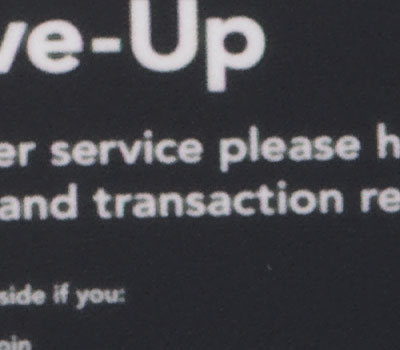
A detail of the left sign.
The biggest failure, for me, is that this should have been in color. I definitely need to order some color film. There are some pictures I want to do that want to be black and white but this one, and other pictures around Whidbey Island I want to do, should be in color. That decision was certainly influenced by recently reading Stephen Shore's Uncommon Places as well as books by Joel Sternfeld and William Eggleston that I will post about later.
At the same time I was deciding to do large format color I ran across a thread at Rangefinder Forum titled: Polaroid RF conversions to sheet film & roll film.... Hmmm. I had been planning to use my 3 1/4 x 4 1/4 Speed Graphic for hand held large format but being able to convert an old Polaroid camera to 4x5 would make a smaller package that would also allow me to us my 4x5 Polaroid film back. Reading that thread sent me into a googling frenzy. There are all sorts in interesting conversons. Some involve the early professional Polaroid 110b.
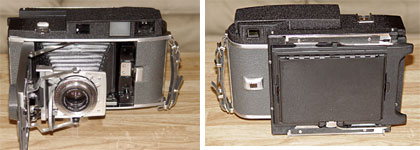
This one cut the back and installed a 4x5 Graflok back. The 110b has a nice lens, which most Polaroids don't. But $100 is about the minimum you will pay for one. Another option, and a cheap option it is, is the Polaroid Automatic 250.

That is actually a 180 which is the same as the 250 but with a real lens. Another Graflok back grafted onto the body. There are two names that come up when searching for Polaroid conversions: Noah Schwartz (the 180 above was from Noah) and Dean at Razzeldog. Dean has done quite a number of interesting Polaroid conversions which he has put on a CD (Scroll down his Polaroid page.) Here is a review of Dean's CD. I have one on order. I also bought a 250 for $5 plus $10 shipping.
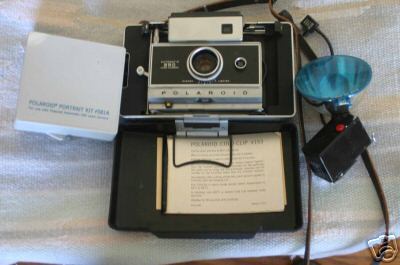
Zoe actually has one of these but she said bad things to me when she wanted to know what I was looking at her 250 and I told her about how it could be converted to 4x5. It does have a lovely rangefinder but a sucky lens. But I alread have a good lens. It's a Kodak Ektar 127mm that is on the Speed Graphic. It would work fine on the Polaroid. It would be equivalent to a 36mm lens. And I have a Graflok back. I've been using it on the Burke & James. I thought about buying another but $50 saved means $50 for film. I thought about it real hard and came to another decision. I have the 4x5 Graflok back and the original 5x7 back that needs glass and some repair. I've not been able to figure out when I would use the 4x5 and when to use the 5x7. There was also the redundancy in my lenses. Here is a chart showing the equivalency in 35mm lenses.
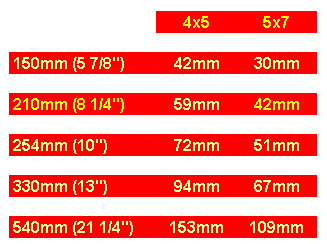
You can see how the 15omm on the 4x5 is the same as the 210mm on the 5x7. This happens all the way down the chart. There is a lot of duplication and I decided to cut the duplication by removing the 4x5 Graflok back for the Polaroid and just shoot 5x7 on the Burke & James. I can still screw it back on if I need it for tests (4x5 film or 120 roll film is a lot cheaper).
So Bill's question about Polaroid conversions was a timely whack on the side of the head that opened up new possibilities and gave some new directions. Thanks Bill!
But wait! There's more! Dean's CD has some Polaroid J66 (another cheap Polaroid) conversions into 6x12 and 6x17 flat back panoramic cameras. I have a Wollensak 90mm lens that I was going to use on the Speed Graphic that would be perfect for a 6x12. I await the arrival of Dean's CD. |

